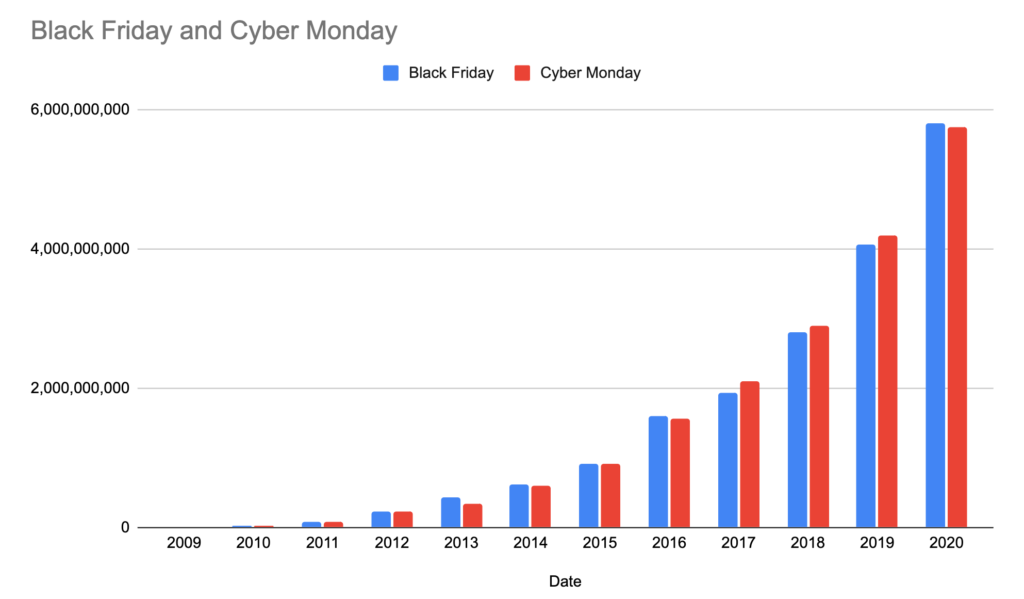First, let me say happy holidays to everyone reading this blog. I hope this recap finds you all well, healthy, and finding a little holiday cheer during what can only be billed as a new normal.
That said, this new normal of ours is just one aspect of a year filled with milestones, never-befores, and first-time-in-a-century type of events. Unprecedented is a word often used to describe this year that’s in its waning days. Yes, this year has been different from previous years, and it should come as no surprise that our habits, rituals, and shopping have changed as a result.
Retail surged 22%, $9 billion, on Black Friday.
Despite an economy bearing the scars of the ongoing pandemic, retail surged 22%, $9 billion, on Black Friday. However impressive, the surge should come as no surprise. More people chose to stay home and shop from the safety and convenience of their mobile devices, laptops, and tablets to avoid crowded spaces.
It makes sense that online sales were markedly higher.
Black Friday and Cyber Monday email volume
It also follows suit that email, the beating heart of online shopping, was also higher—much higher, to put it mildly. On Black Friday Twilio SendGrid processed over 5.8 Billion emails on behalf of our customers. Cyber Monday was no slouch coming in at 5.7 Billion emails.
What used to be a raucous, in-person, no holds barred, human cannonball foot race to the flat screens is now a much more docile swipe fiesta conducted in our social bubbles. There were no apprehensive door monitors that wanted to get out of the way of mobs of price hunters swooping down on big-box retailers to snatch up as many bargain-priced gifts and goods as possible.
No, this year was definitely not that.
Holiday open rates
One thing that jumped out at us as we analyzed our holiday data was a slight shift in open rates from 2019. Last year we saw higher open rates peaking around Black Friday and then gradually declining going into Cyber Monday. This year we had nearly the same behavior but with a marked difference: Cyber Monday’s open rates soared!
This monumental open rate makes sense when you consider that Cyber Monday delivered $10.8 billion in spend, 37% of which happened on smartphones! One of the trends we noticed was more scheduled holiday emails on Black Friday and a noticeable increase in transactional order confirmations on Cyber Monday.
These all make sense when you take into consideration that the vast majority of us stayed home, avoided stores and crowds, and as some analysts pointed out, started shopping earlier. I also think it’s possible that consumers simply bought more given how much we’re all buying on a daily basis as a result of our new normal.
Email is more crucial than ever
The pandemic has changed our world—there’s no denying that. Companies have undergone digital transformations in real-time to adjust and accelerate their businesses. Retailers with healthy foot traffic have scrambled to build new virtual experiences, fulfill online orders, and provide curbside pick up. This doesn’t even begin to describe the evolutionary adaptation that’s happened across health care, education, and working from home.
What’s become acutely evident through all of this change is that email is more crucial than ever.
Those of us with graying beards and long memories should remember the overuse of the term digital glue: email was digital glue for social media when it was in its infancy, for burgeoning e-commerce, and a number of other early services online. Not too many thought leaders use the term digital glue to describe email anymore—that was then. Like all things old becoming new again, the term digital glue is an apt description for email.
Today, email not only binds the ephemeral digital services that rely on it as a basic identifier, but in countless use cases acts as your passport by which you can complete a curbside pickup for food, groceries, and other goods.
Countless times we’ve heard people decry that email is dead or will be dead (and some specific enough to call out 2020 as the year it’ll happen), that messaging services will replace email, or that AI and ML will tame the unruly inbox. We can all agree that most of that (if not all) didn’t come to pass.
Email has proven its ability to adapt and evolve.
What has happened is that email has evolved. The community supporting the email ecosystem, from mailbox providers such as Gmail, Yahoo!, and Microsoft to email service providers like Twilio SendGrid, have pitched in to make it more secure by promoting standards such as DMARC and BIMI while also helping businesses take advantage of a cost-effective and universally accessible means of responsibly connecting people to brands.
Know it or not, the forebearers of email created a service built for this time, and I (for one) am glad to be able to help us stay connected through the magic of our tried-and-true inboxes.
Want more insight into what you can expect for the remainder of the pandemic holiday seasons? Don’t worry we have you covered! The retailer’s complete guide to a pandemic holiday season!

